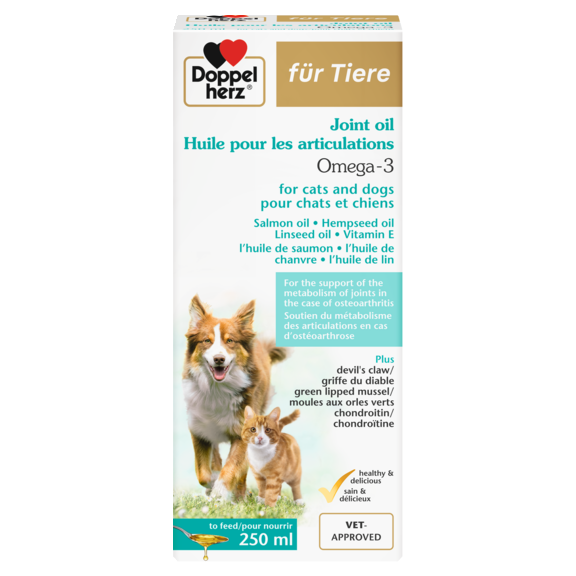The correct and healthy interaction of the entire musculoskeletal system is an important basis for enjoyment of life and health. Large breeds in particular are known for developmental disorders of the skeleton and diseases of the joints, but smaller breeds can also suffer from joint problems.
If a dog suffers from diseases of the musculoskeletal system, this not only restricts the dog physically in its movements, but also causes pain at the same time, which can cause a loss of joy in life.
Especially in older animals, joint problems and arthrosis can increase over the years. But younger dogs can also be affected by considerable complaints due to growth disorders, genetic predispositions or injuries. However, there are various remedies available for joint and wear diseases as well as signs of old age that can definitely help the dog.
Even more important than the treatment of existing diseases, however, is the optimal prevention of joint diseases in order to minimise or, if possible, completely avoid joint damage.

Dog owners can therefore specifically promote the dog's joint health and avoid wear and tear diseases as far as possible.
- Avoidance of overweight
A healthy weight is important at any age of the dog. No matter if puppy, young dog, in the best age or dog senior - overweight damages the joints of the dog in every phase of life and favours arthrosis.
Weight checks should therefore be carried out regularly to prevent weight problems at an early stage. Overweight dogs with joint problems should definitely lose weight in order not to further promote existing arthrosis. - Individual and age-appropriate movement
Exercise is important for both two and four-legged friends and supports joint health. However, it should be ensured that the dog warms up a little first when going for a walk and runs loosely instead of chasing a ball directly. The dog should also be able to move freely and not be unnecessarily constricted in order to supply the cartilage with sufficient nutrients through complete joint movements. - Joint-friendly surface
Two-legged endurance runners are advised not to run continuously on asphalt or stone roads, as these promote wear and tear on the joints. This also applies to dogs: forest and field paths as well as meadows provide better cushioning when running, jumping and romping around and are therefore a more joint-friendly option for joint walks. It is equally important to choose a place to sleep that Is easy on the joints. A soft blanket, dog cushion or other fluffy sleeping area should be provided for the four-legged friend to avoid calluses and painful pressure on the joints from outside. Special orthopedic dog beds are also available. - Everyday aids
Dogs can climb or jump stairs on their own, but aids are recommended for larger differences in height. For example, ramps in the boot of the car or climbing aids to the favourite sleeping place on high can prevent overloading the dog's joints. - Swimming
Exercise and dog sports mainly become difficult when dogs already suffer from osteoarthritis. Swimming or targeted water therapy as a physiotherapeutic treatment can help to build up muscles, thereby relieving and consequently supporting dog joints. Swimming is easy on the joints as there is no direct strain and the four-legged friends can keep fit without much joint pain. - Joint-healthy diet
Attention should be paid to a species-appropriate and healthy diet in all phases of the dog's life. To support the joint metabolism and musculoskeletal system, supplementary feeds are available for dogs, which usually contain nutrients that are not sufficiently present in everyday dog food, but can have a positive effect on joint and wear diseases such as arthrosis as well as inflammations.
The cartilage substance consists to a large extent of glucosaminoglycans (GAG) such as chondroitin or glucosamine. These components are important for the optimal structure and function of the cartilage. Collagen is also an important component of articular cartilage.
Inflammation is the driving force for a progressive course in joint diseases such as osteoarthritis. Omega-3 fatty acids have been shown in studies to have anti-inflammatory properties.* Dietary foods to support joint function therefore always contain a high level of omega-3 fatty acids. They are mainly found in linseed oil and fish oil such as salmon oil in high potencies and can help prevent joint inflammation. In addition to essential omega-3 fatty acids, the green-lipped mussel (Perna canaliculus) also contains valuable glycosaminoglycans such as chondroitin sulphate and glucosamine.
Natural ingredients such as devil's claw and Boswellia serrata (Indian frankincense) should not be missing from the list. Devil's claw is an African plant that has been used by the natives for many centuries and is used as a phytotherapeutic agent for musculoskeletal pain caused by wear and tear. Indian frankincense is used in traditional medicine because of its essential oils and so-called boswellic acids.
In particular, a high-dose combination of these different ingredients represents a sensible protection against joint disea ses and can help to support joint function in the case of already existing symptoms of signs of ageing, wear and tear diseases and inflammation caused by arthrosis.
*Fritsche (2015): The science of fatty acids and inflammation. Adv Nutr. 6(3):293S-301S.
Moreau et al. (2012): Effects of feeding a high omega-3 fatty acids diet in dogs with naturally occurring osteoarthritis. J Anim Physiol Anim Nutr (Berl). 2012 Jul 14
Peanpadungrat (2015): Efficacy and Safety of Fish Oil in Treatment of Knee Osteoarthritis. J Med Assoc Thai. 98 Suppl 3:S110-4.

